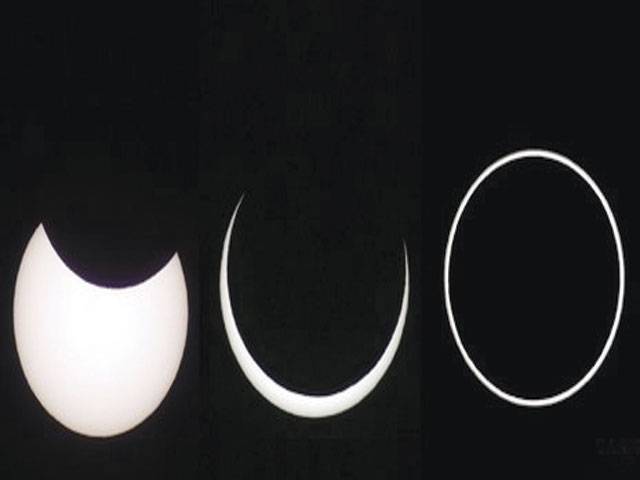BBC
WASHINGTON
A rare solar eclipse allowing a view of the Sun that is totally or partially blocked out by the Moon has begun. It is first visible in the southern United States, and is moving east, The best view of the total eclipse on land will be in Gabon at about 13:50 GMT. The total eclipse will then sweep east across the African continent. Partial views will be available in eastern North America and southern Europe. Experts warn that no-one should attempt to view the Sun with the naked eye. A safe view of eclipses can be obtained by using special welder's glasses or a pinhole camera. This solar eclipse is a rare occurrence in that it is "hybrid" - switching between an annular and total eclipse. In a total eclipse, the Moon completely covers the sun, while an annular eclipse occurs when the Moon is at its farthest from the Earth and does not block out the Sun completely, leaving a halo of sunlight still visible around the Moon.
The eclipse event was due to begin about 1,000km (620 miles) east of Jacksonville, Florida with an annular eclipse visible for four seconds at sunrise (11:05 GMT), Nasa said. As the Moon's shadow races east the eclipse will switch from annular to total along a narrow corridor. Greatest total eclipse will occur in the Atlantic Ocean at 12:47 GMT, approximately 330km south-west of Liberia, for more than one minute.
On land, the best total eclipse will be visible in Gabon. "The eclipse will then continue across Africa through the Congos until it passes through northern Uganda and northern Kenya, ending in southern Ethiopia and Somalia," said the International Astronomical Union. Either side, a partial eclipse will be seen within a much broader path including eastern North America, northern South America, southern Europe, the Middle East and Africa.
Friday, April 19, 2024
Rare solar eclipse in 3 continents

King Charles's cancer ‘eating him alive,' monarch unable to perform duties: Insider
1:02 AM | April 19, 2024
Mehwish Hayat says she would like to work with Aamir Khan
9:59 PM | April 18, 2024
What caused record-breaking rainfall in UAE?
9:58 PM | April 18, 2024
Donald Trump discusses Ukraine, Middle East, NATO with Polish President Duda
9:57 PM | April 18, 2024
'That'll be awesome,' Rohit Sharma on idea of Pakistan vs India Test series
9:17 PM | April 18, 2024
Hepatitis Challenge
April 18, 2024
IMF Predictions
April 18, 2024
Wheat War
April 18, 2024
Rail Revival
April 17, 2024
Addressing Climate Change
April 17, 2024
Justice denied
April 18, 2024
AI dilemmas unveiled
April 18, 2024
Tax tangle
April 18, 2024
Workforce inequality
April 17, 2024
New partnerships
April 17, 2024
ePaper - Nawaiwaqt
Advertisement
Nawaiwaqt Group | Copyright © 2024





